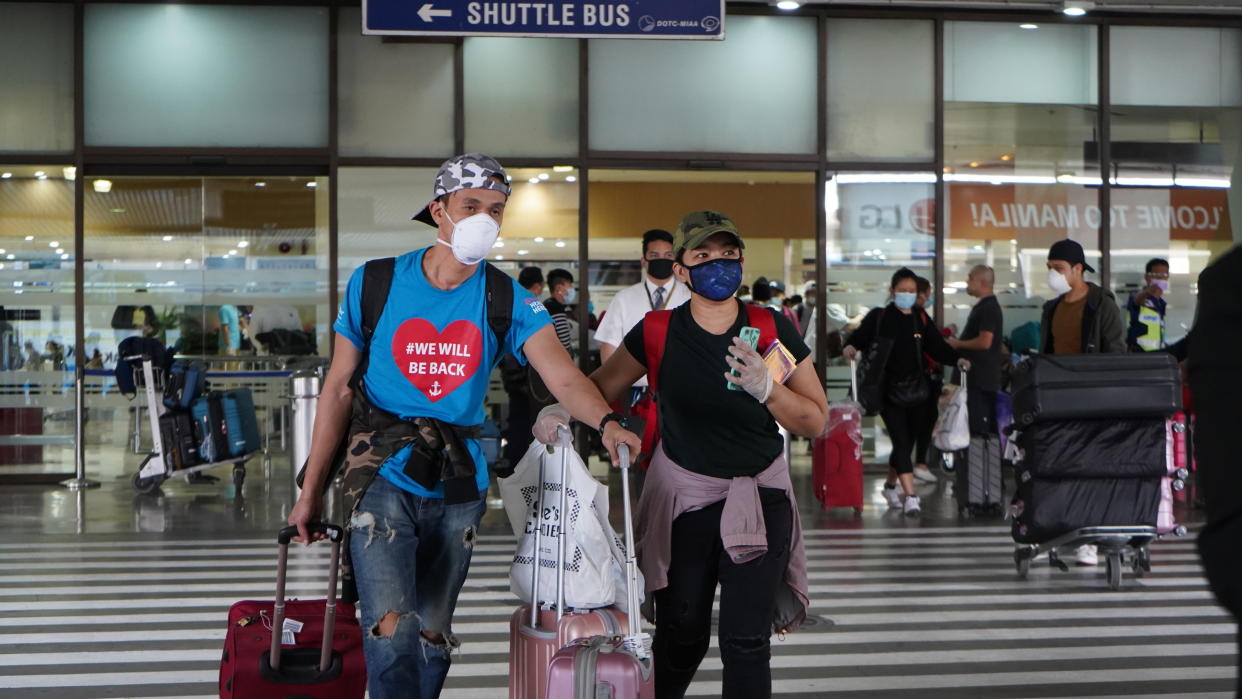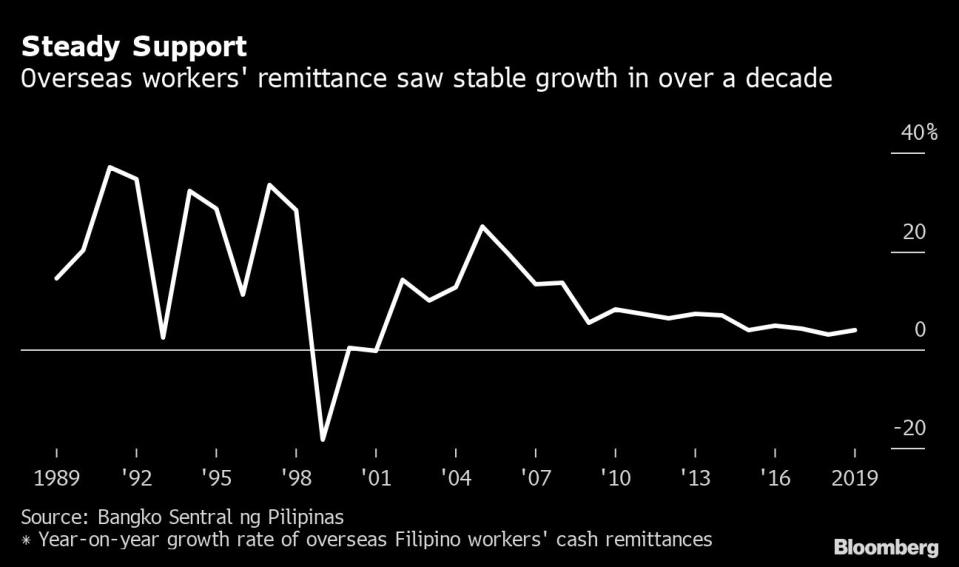Job Losses Drain Overseas Money That Helps Fuel the Philippines

By Siegfrid Alegado
For millions of Filipinos, money sent home by a relative working overseas can make the difference between hunger and survival. This year, those funds may not arrive.
With coronavirus bringing the global economy to a standstill, planes carrying workers from abroad back to the Philippines have become a common sight at Manila’s airport. The government has repatriated more than 17,000 Filipinos who lost their jobs because of lockdowns abroad. Thousands more are believed to have returned on their own, while others who’ve lost jobs choose to wait it out overseas.
Beverly Pacultad, 40, returned March 23 from Hong Kong, where she’d been employed as a domestic helper.
The mother of three had arrived in Hong Kong in November, hoping to save enough to send her oldest daughter to college. She earned twice as much looking after a toddler there as she did as a teacher in Manila, and was able to remit about 40,000 pesos ($788) to her family. When the pandemic struck and Hong Kong shut schools and businesses, her employer -- a Chinese family -- decided to return to the mainland, no longer needing her services.
“My family depends on me,” Pacultad said. “My situation flashed before me: Now I don’t have a job.”
Essential Support
The worldwide surge in job losses is upending the $690 billion global remittance industry, an essential support for many developing economies. Citigroup Inc. estimates that global flows could plunge by as much as $100 billion under a worst-case scenario.
Remittances to the Philippines reached $30 billion last year, making it one of the biggest foreign-exchange earners after exports. Remittances amount to about 10% of the country’s gross domestic product, a far higher proportion than in places like India and China, which also have vast numbers of citizens working abroad.
The remittance flow to the Philippines hasn’t declined in any year since 2001, not even during the global financial crisis, according to central bank data. This year it may fall 30%, the country’s former economic minister said earlier this month.
“In the past, the diverse spread of overseas Filipino workers globally has supported remittances” even during crises, Sanjay Mathur, a Singapore-based economist at Australia & New Zealand Banking Group Ltd., wrote in a recent report. The pandemic has spread so widely “that there are almost no pockets of growth in any geography which hosts a meaningful share of remittances.”

More than 2 million Filipinos, from a total population of about 100 million, head abroad for work each year, most as laborers or service and sales staff. The country also supplies a quarter of the world’s merchant marine workforce.
The Philippines is the fourth-largest recipient of remittances globally, according to World Bank data. About 75% of that money is spent, with much going for essentials like food, education and health care, according to ANZ’s Mathur.
Read: Remittances Play Crucial Role in IMF Hierarchy of Needy Nations
In a joint statement April 16, more than 90 organizations serving overseas workers outlined their plight.
Foreign workers, “who were already in the margins even before the outbreak, have now fallen or are in real danger of falling off the cracks as governments abandon us to fend for our health and economic needs,” the groups said. The government “has made our situation worse with its absence of comprehensive assistance plan during lockdown as well as inaction on our concerns in countries where we live and work.”
Migrant workers stuck in Manila en route to their jobs overseas stay at a temporary housing dorm in the Philippines capital,Feb. 13.
Requests for comment from the Overseas Workers Welfare Administration, part of the Department of Labor and Employment, went unanswered. In a statement Sunday, the department said it had assisted nearly 26,000 workers stuck overseas, and that another 30,000 had applied for benefits under a 1.5-billion peso government assistance program for displaced workers.
The government also offers other forms of aid for returning workers such as temporary shelter at halfway homes, stress debriefing and transport from Manila to their home provinces.
Stable Pillar
Beyond the impact on families, the slump in foreign inflows could strain the country’s balance of payments and weigh on the currency amid heightened market turmoil. It also could force the central bank to tighten monetary policy sooner than planned and raise the risk of prolonged economic weakness, said Shilan Shah, an economist at Capital Economics Ltd. in Singapore.
Remittances “continue to be one of the most stable sources” of foreign exchange for the Philippines, supporting the peso and driving consumption, central bank Governor Benjamin Diokno said in emailed comments earlier this month. Policy makers are watching developments closely, he said.
So, too, is Pacultad. Back home near Manila, she’s living from what she managed to save in Hong Kong, and has applied for 10,000 pesos in government aid.
She still exchanges mobile-phone messages with her former employer, who has promised to rehire her one day if the situation improves.
“I was told I can go back there if things get better,” Pacultad said. “But when will things be better?”
© 2020 Bloomberg L.P.


